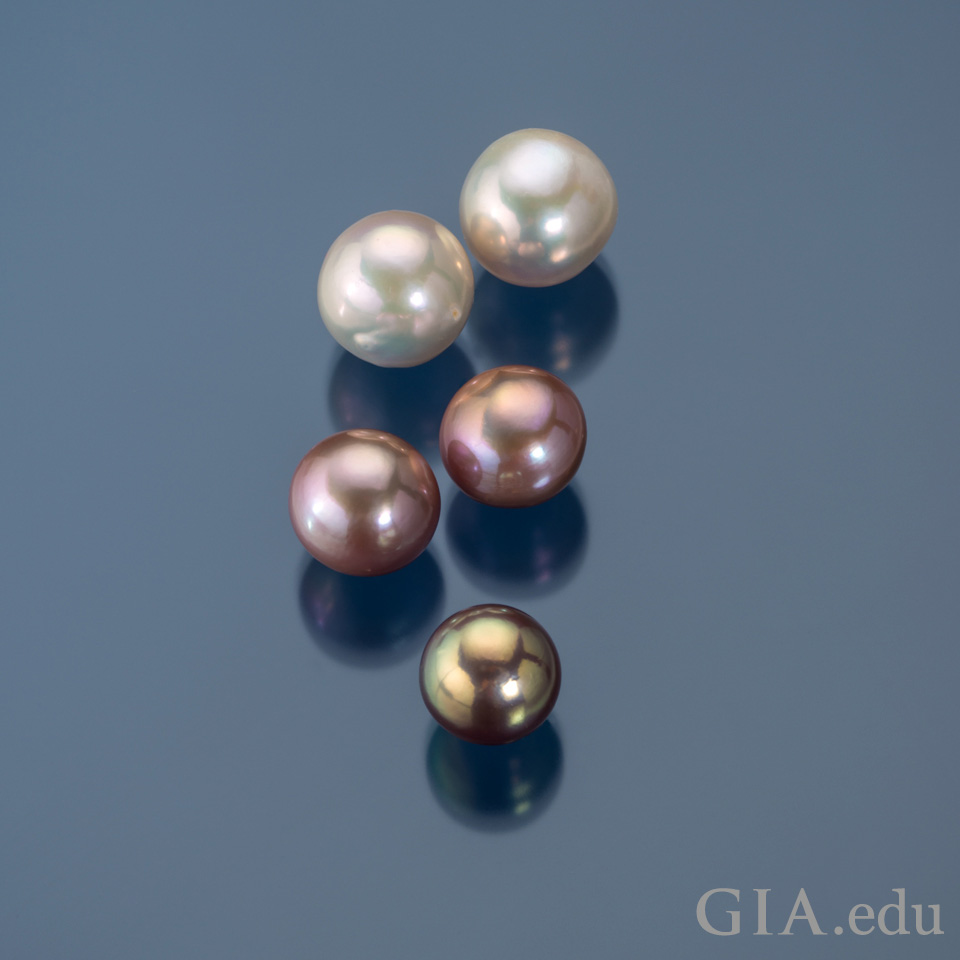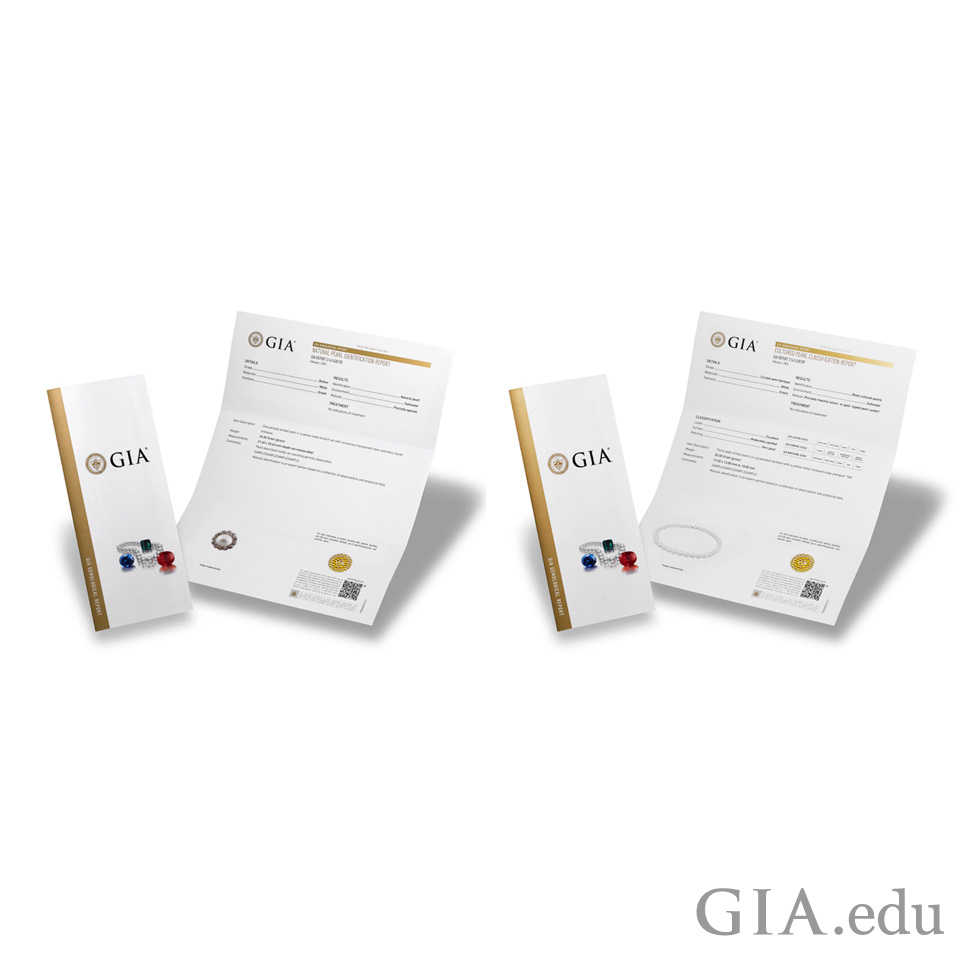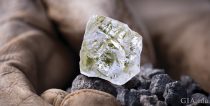If pearls are your gemstone of choice, you’ll want to learn more about GIA’s 7 Pearl Value Factors™ – the criteria GIA uses to classify and describe pearl quality. Read on to learn about how pearl quality is determined and what you can do to find out how your pearls measure up.
Just as quality influences diamond price, the same is true for pearls. So, in this blog post, you’ll learn about these criteria, get an overview of GIA’s pearl classification process, and see how GIA uses the pearl classification system it developed to evaluate pearls.
GIA developed the 7 Pearl Value Factors for the same reasons it developed the 4Cs of diamond quality: to establish a standard terminology for describing pearl quality, using language everyone can understand. And just as GIA defined the methods and best practices for evaluating diamond quality, so too it defined the procedures for evaluating pearls. Like diamond grading, pearl classification is a complex process that takes a trained gemologist time and extensive knowledge to execute.
So let’s dive into pearls to learn about the factors that influence their value, how they are assessed, and how GIA Pearl Reports can help you understand the classification of your natural or cultured pearl.
You’re sure to be a well-informed pearl shopper in no time!
About Nacreous Pearls
Pearls can be found in saltwater and freshwater mollusks. When the mollusk secrets an iridescent substance, called nacre, around an irritant, it forms a natural or cultured pearl. Natural pearls occur when the irritant, such as a minute organism, accidentally enters the mollusk. When humans introduce the irritant, the end result is a cultured pearl.
Not all mollusks secret nacre. When there is no nacre, the pearls are referred to as non-nacreous pearls. Conch pearls and Melo melo pearls are non-nacreous in form (sometimes referred to as porcelaneous pearls) produced by snails (gastropods) which are univalve mollusks.

Chinese freshwater cultured pearls in white, pink, and pistachio. Photo: Robert Weldon/GIA. Courtesy: Betty Sue King, King’s Ransom.
Describing Pearl Quality: GIA’s 7 Pearl Value Factors
Pearls come in a wide variety of sizes, shapes, and colors. GIA’s 7 Pearl Value Factors provide a common language to describe them and communicate their quality:
1. Size
The size of round and near-round pearls is expressed in terms of their diameter measured in millimeters. One millimeter is about 1/25 of an inch. Other shapes are measured according to their length/depth and diameter/width.
2. Shape
The three main categories of shape are spherical, symmetrical, and asymmetrical (semi-baroque and baroque). Pearls come in seven basic shapes: round, near-round, button, drop, oval, semi-baroque, and baroque.
3. Color
There are three components: bodycolor (dominant, overall color of the pearl), overtone (one or more translucent colors that lie over the bodycolor), and orient (iridescent rainbow colors that shimmer on or just below a pearl’s surface). Note: not all pearls will exhibit all three characteristics.

The natural-colored cultured pearls in this strand include pastel freshwaters from China, grays from French Polynesia, “goldens” from the Philippines, and whites from Australia. Photo: Robert Weldon/GIA. Courtesy: King’s Ransom
4. Luster
Luster is the intensity of light reflected from a pearl’s surface. Luster is one of the factors that give a natural or cultured pearl its unique beauty. Pearls with excellent luster have sharp bright reflections on the surface. Different pearl varieties have different standards for luster. The GIA Luster Scale ranges from Excellent to Poor.
5. Surface
Pearls commonly have blemishes or irregularities that are normally confined to the surface. Surface characteristics are judged by size, number, location, visibility, and the types of blemish. If surface characteristics are numerous or severe, they can affect the durability of a pearl and severely lower its value. They have less effect on the pearl’s beauty and value if they are few in number, or if they are minor enough to be hidden by a drill-hole or mounting. The GIA Surface Scale classifies pearls as Clean, Lightly Spotted, Moderately Spotted, or Heavily Spotted.
6. Nacre Quality
Nacre is the substance that makes up a pearl, layer after layer. Thickness is important when evaluating nacre quality to make sure that cultured pearls are durable as well as beautiful. Nacre thickness measurements are provided as optional descriptions on GIA pearl reports. However, GIA pearl reports will clearly note if the nacre coating is too thin and/or damaged, thereby posing a potential impact on a pearl’s durability. Natural or non-bead cultured pearls with nacre quality issues (damage will also be noted).
7. Matching
This relates to the uniformity of pearls in strands, earrings, or other multiple-pearl jewelry items, and is highly dependent upon a skilled grader to determine matching the other six value factors. The GIA Matching Scale ranges from Excellent to Poor, or listed as Not Applicable for single pearls and certain intentionally mismatched jewelry items.
Each value factor is important in determining a pearl’s overall quality. Now that you’re knowledgeable on GIA’s 7 Value Factors, see how they’re applied in a laboratory environment.

See how matching comes into play as a pearl quality factor in these different strands of cultured pearls: Tahitian (top two rows), Chinese freshwater (third row), South Sea (fourth row), and akoya (bottom two rows). Photo: GIA and Harold & Erica Van Pelt. Earrings courtesy: Mastoloni, New York, South Sea strand courtesy: The Collector Fine Jewelry, Fallbrook, Calif.
How GIA Classifies Pearls
Using standard and advanced testing equipment, gemologists specializing in pearls identify the pearl type (whether it is natural or cultured), and look for evidence of treatments. The pearl is weighed with an electronic micro-balance, and its size is measured in millimeters using special digital calipers. The pearl is then compared to a set of carefully pre-selected pearl masters to determine color and classify the other value factors. A second team of pearl specialists independently repeat all necessary observations and testing to ensure a precise and objective evaluation.

When matching fine quality pearls, the result can be beautiful. A South Sea cultured pearl necklace, bracelet, earrings, and ring suite. Photo: Robert Weldon/GIA. Courtesy: Fine Gems International
Because lighting, background colors, and other environmental factors can influence observations, controlling the pearl grading environment is critical. Staff examine the pearls against a neutral gray background, using a daylight equivalent light source. Sitting about one foot away from the pearl, they rotate it to get an overall impression, as they compare it to pearl masters.
This specific environment, along with the tests and the procedures conducted during the examination, were developed by GIA to ensure repeatable, accurate, and dependable results, so that pearl buyers can rely on an objective pearl assessment based on GIA’s 7 Value Factors.
GIA issues two types of pearl reports for loose, strung, or mounted natural or cultured pearls: Identification and Classification Reports. Learn what each report offers and the differences between the two.
GIA Pearl Identification Report
The Identification Report confirms that the pearl(s) is/are natural or cultured, not a simulant or imitation, and describes any detectable treatments. In addition, the report provides the weight, size, shape, and color, as well as mollusk species that produced it (when possible), and the environment it formed in (freshwater or saltwater). The report further documents the pearl(s) by providing a full color image captured during the identification process.

GIA Pearl Identification and Classification Reports help you understand the pearl quality of your pearl jewelry.
GIA Pearl Classification Report
The Classification Report is available for untreated, nacreous pearls only. It provides the same information as the Identification Report, as well as an assessment of a pearl(s) luster, surface condition, and matching (if applicable).
If you own a beloved strand of pearls, or pair of earrings, a Pearl Classification Report would be helpful to better understand the pearl quality in your jewelry. While you are shopping, remember Report Check is also available for pearl reports – a convenient confirmation that the information on your report matches GIA’s report database. This provides an additional level of assurance and is available for pearls, diamonds, and all colored stone reports issued by GIA.
If you’re interested in learning about different types of pearls, take a look at our blog posts:History of Cultured Pearls and History of Cultured Pearls: South Sea and Tahiti. Then, check out this noteworthy natural pearl once owned by Spanish royalty and later, Elizabeth Taylor:La Peregrina.
Header photo: Robert Weldon/GIA







